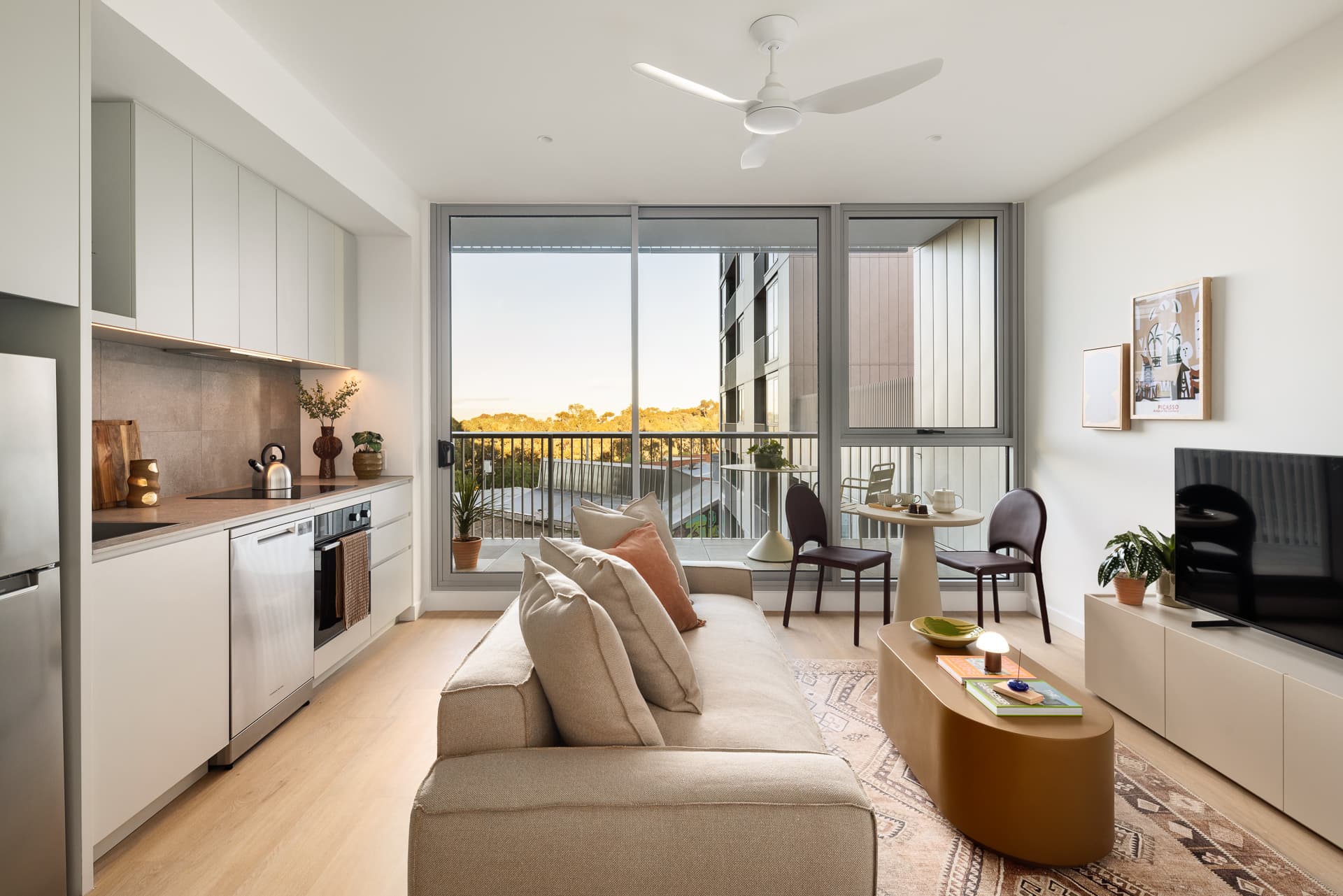People, Place and Purpose: Re-imagining communities in 2050
Robots that cook dinner for you, capsule hotels for commuters, space tourism and brain optimisation spas are just some of the big ideas being discussed for our world in 2050.
They’re bold and they’re big and they certainly grab the imagination, which has us at Mirvac thinking about what a home and community looks like in 30-something years’ time.
We can dream about what technologies we will have at our fingertips, but the most exciting insight from a planning perspective is how these advances will influence our day-to-day lives - and how we can plan for that.
Mirvac places at its heart our purpose to reimagine urban life. I am passionate about thinking ahead and putting plans in place so that we are delivering great outcomes for our communities today and into the future, creating legacies that stand the test of time.
And when I think about the road to 2050, I realise how important good design, infrastructure, community well-being and integrated technology are for the places we build now - paving the way for that journey.
Because we know that our cities are growing. Sydney’s population alone is expected to exceed 7.4 million by 2050 and how we manage this growth is key. In its recent report, ‘Future Cities’ Infrastructure Australia highlighted that Melbourne is at risk of losing its status as one of the world’s most liveable cities unless smart decisions are made about how to accommodate the city’s growing population. The report suggests that by 2046 those in major cities will have poorer access to jobs, schools, housing and green space.
And while a lot has and will continue to change in urban life, living comfortably in a place you can call home does not.
Making the right decisions for Australians and the way we live while planning our cities so they use space well and create a strong sense of place, preserving our neighbourhoods and local feel, are key to enhancing and preserving the Australian way of life in 2050. It is a responsibility which Mirvac as a leader in the creation of outstanding urban environments takes seriously.
What is exciting to me about these challenges for how we live, work and play, is that in essence, these are not just liveability challenges, but design challenges. And design challenges that we can solve.
For me, the most exciting conversation to be had is: what will our communities and our cities be like in the decades to come?
I’ve put together a few of my thoughts on how we might reimagine communities in 2050.
Reimagining Our Neighbourhoods
The smart use of space and a whole of place response are two ways Mirvac believes the property industry can build a bright future for Australia in 2050.
Part of this will come through in the move towards 20-minute neighbourhoods and the continued creation of lifestyle cores outside of CBDs. We are already seeing this with Green Square, where in partnership with the NSW Government, we have created a self-sustaining community that is now taking shape.
When we have the opportunity to build an environment with a holistic community lifestyle in mind we can deliver an integrated environment that can meet the community’s needs for generations.
Green Square’s high street retail precinct and commercial spaces are surrounded by parks and substantial amenity including a civic plaza, library, aquatic centre, child care and a new public school. And when the first release sells out in a weekend, with many buyers repeat Mirvac customers, you get a strong sense that we’re creating spaces which are reflective of buyers’ changing needs: vibrant inner-city communities with green space, links to transport and shared amenities.
It is also evidenced in Brisbane and Melbourne where we are planning communities with walkable neighbourhoods connected to amenity such as schools, shops and local services.
What we are already delivering in Green Square in Sydney is well aligned with the notion of the 20-minute neighbourhood. The ability for city-dwellers to meet most of their everyday needs within a 20-minute walk, cycle or local public transport trip of their home. These needs include schools, shops, meeting places, open spaces, cafes, doctors, childcare and access to public transport.
Reimagining Our Homes
Our changing demographics and lifestyle has seen housing designs change dramatically. This will continue with the rise of technology and robotics.
The homes of the future will still have walls and a roof - the fundamentals - but they will operate and enhance our lives in completely new ways.
So when futurists talk about robots cooking dinner, we at Mirvac need to think about how to design a butler’s pantry in a kitchen that can accommodate and power the robotics and technology that will enhance our daily lives. For example, we have now implemented car charging stations into our garage designs to accommodate electric vehicles.
But how do you do more with less? How do you design homes that can adapt and embrace technology while doing so cleanly and efficiently?
At Mirvac, we believe in leaving a sustainable legacy and those future generations should inherit the best that we can offer. That’s why in Victoria we have developed a pilot program - the House With No Bills - that aims to uncover how we will deliver energy efficient homes to the mass market. We know that energy bill shock is causing real stress to people everywhere, and we want to be able to provide excellent quality which lowers maintenance costs, including with energy. And of course, with better energy efficiency, we’re serving our planet better too. Through effective design and integration of innovative sustainable technology, we can maximise the home and its surroundings to reduce reliance on energy — ultimately eliminating bills for energy and other elements of cost of living.
Completion of the study will then see learnings integrated into new communities, and in 30 years’ time, our reality could be entire communities with no bills and a leap forward in sustainability.
The future in 2050 will definitely see entire off-grid neighbourhoods and we are taking the first steps towards that today.
Elysa Anderson (right), Mirvac’s General Manager, Residential Victoria with the Hon. Lily D’Ambrosio (left), Minister for Energy, Environment and Climate Change at the launch of House with No Bills.
Reimagining Our Workplaces
More of us than ever are working from home — almost one-in-three of the Australian labour force report their home doubles as an office space. Unfortunately nearly half of the 3.5 million people who often work from home in their primary employment say they do so to "catch up" on their heavy workloads.
And while I have been known to fall into this category, it’s in-part this challenge of work-life balance that allows urban designers to influence the solution — and that excites us about the future.
The flip side for many Australians working from home is that they are choosing this option so they can have a ‘rent-free’ home office, take advantage of flexible workplace arrangements, for childcare reasons and to spend more time with family. The rapid rise in Australia’s gig economy also means more and more workers are seeking flexible working spaces to support their contract, freelance and part-time roles.
Designing a functional office space into the ground floor of Mirvac’s Cargo Homes is reflective of shifts in employment trends and society’s growing demand to regain work-life balance. As we look decades into the future we must acknowledge this takes a different form to what our parents once sought and instilled as ‘balance’ when we were growing up.
The notion of Monday-Friday/9-5 is now antiquated. So if our working hours are not declining and the magic ‘888’ is further from reach than ever, we need to be looking at urban design that instead facilitates ‘work-life rhythms’ and reflects the increasingly blurring line between work and play.
Launching our Cargo Homes at Yarra’s Edge in Melbourne unveiled a design which integrates home office space on the ground floor and living spaces on the top two floors. This comes with the added bonus of having the flexibility to adjust spaces reflective of how life and work may evolve over time.
While home offices will never replace cities as work connectivity hubs, creating these functional spaces in the home offers the important opportunity to regain lifestyle balance, but can also reduce congestion in major cities. NRMA studies show that reducing traffic by five percent can increase traffic speeds by 50 percent and with renewed calls from economists and planners to implement congestion taxes in major cities, diverting segments of our workforce to the home-office can achieve significant benefits for our urban populations.
The future of home, neighbourhood and workspaces and places is what excites me most about the property industry, the work I do and the team I lead. Taking function and form and putting people at the centre of it all while thinking 30 years ahead is what leads to great design.
So, while gazing into the future takes imagination and some bold new thinking, it’s exactly this type of bold thinking and imagination that will make our future, and our homes, brighter.

Mirvac acknowledges Aboriginal and Torres Strait Islander peoples as the Traditional Owners of the lands and waters of Australia, and we offer our respect to their Elders past and present.
Artwork: ‘Reimagining Country’, created by Riki Salam (Mualgal, Kaurareg, Kuku Yalanji) of We are 27 Creative.




